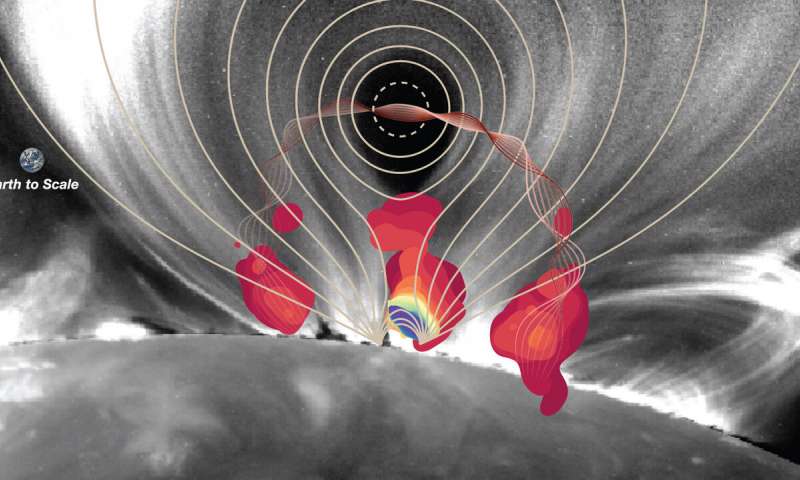HOME
Researchers offer unprecedented look into 'central engine' powering a solar flare

Observation of a large solar flare on Sept. 10, 2017 in extreme ultraviolet (grayscale background, by NASA's Solar Dynamics Observatory) and microwave (red to blue indicate increasing frequencies, observed by the Expanded Owens Valley Solar Array). Light orange curves are selected magnetic field lines from the matching theoretical solar eruptive flare model. The flare is driven by the eruption of a twisted magnetic flux rope (illustrated by a bundle of color curves). Microwave sources are observed throughout the central region where a large-scale reconnection current sheet --the flare's "central engine" -- is located and are used to measure its physical properties. Credit: CSTR/NJIT, B. Chen, S. Yu; NASA Solar Dynamics Observatory
In a study published in Nature Astronomy, an international team of researchers has presented a new, detailed look inside the "central engine" of a large solar flare accompanied by a powerful eruption first captured on Sept. 10, 2017 by the Owens Valley Solar Array (EOVSA)—a solar radio telescope facility operated by New Jersey Institute of Technology's (NJIT) Center for Solar-Terrestrial Research (CSTR).
The new findings, based on EOVSA's observations of the event at microwave wavelengths, offer the first measurements characterizing the magnetic fields and particles at the heart of the explosion. The results have revealed an enormous electric current "sheet" stretching more than 40,000 kilometers through the core flaring region where opposing magnetic field lines approach each other, break and reconnect, generating the intense energy powering the flare.
Notably, the team's measurements also indicate a magnetic bottle-like structure located at the top of the flare's loop-shaped base (known as the flare arcade) at a height of nearly 20,000 kilometers above the Sun's surface. The structure, the team suggests, is likely the primary site where the flare's highly energetic electrons are trapped and accelerated to nearly the speed of light.
News Source